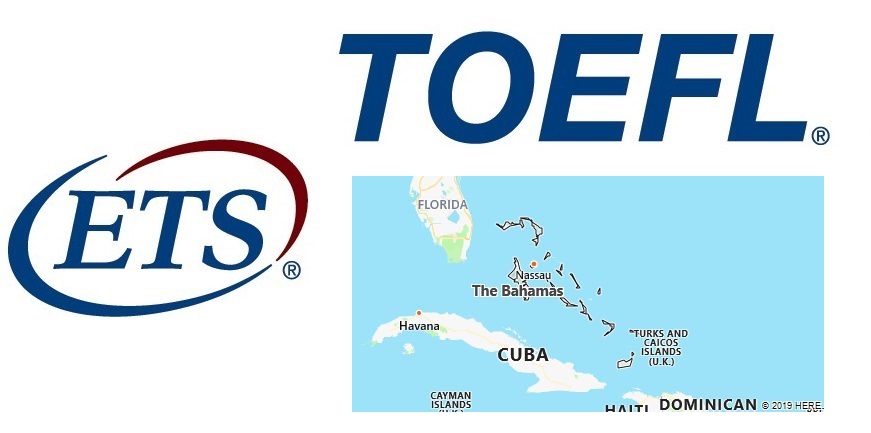The TOEFL iBT test is offered in this location.
The list below shows testing regions, fees and dates as of February 15, 2019, but availability may change when you register. Fees are shown in US$ and are subject to change without notice.
| Region | Testing Format | Fee | Test Dates |
|---|---|---|---|
| Nassau | TOEFL iBT | $180 $180 |
Fri., Apr 05, 2019 Fri., Jul 12, 2019 |
Bahamas Overview
Bahamas, island nation in the Atlantic Ocean north of Cuba, a parliamentary monarchy in the Commonwealth. The state includes the Bahama Islands , about 700 islands, of which only the 30 largest islands are inhabited. Over 90% of the population have African ancestors, around 5% are white (mostly descendants of British settlers). The most important branch of the economy is tourism, which is favored by the mild tropical climate and the beautiful sandy beaches.
History: Christopher Columbus first set foot on American soil in 1492 on a Bahama island (San Salvador or Samana Cay). The Bahamas, a British crown colony from 1718, gained independence in 1973.
Country facts
- Official name: The Commonwealth of The Bahamas
- License plate: BS
- ISO-3166: BS, BHS (44)
- Internet domain:.bs
- Currency: 1 Bahamian dollar (B $) = 100 cents
- Area: 13 880 km²
- Population (2018): 385 600
- Capital: Nassau
- Official language (s): English
- Form of government: Parliamentary monarchy in the Commonwealth
- Administrative division: 31 districts
- Head of State: Queen Elizabeth II, represented by the Governor General Cornelius A. Smith
- Head of Government: Hubert A. Minnis
- Religion (s) (2010): Christians (69.9% Protestants [Baptists; Anglicans, Catholics, Pentecostals], 12% Catholics, 13% other Christians), 1.9% non-denominational, 3.2% other / n / a
- Time zone: Central European Time -6 hours
- National holiday: July 10th
Location and infrastructure
- Location (geographical): Atlantic Ocean
- Location (coordinates): between 20 ° 50 ‘and 27 ° 25’ north latitude and 72 ° 37 ‘west longitude
- Climate: Subtropical, moderately humid climate
- Highest mountain: Mt. Alvernia (63 m)
- Road network (2011): 1,620 km (paved), 1,080 km (unpaved)
Population
- Annual population growth (2020): 0.8%
- Birth rate (2020): 14.8 per 1000 residents.
- Death rate (2020): 7.4 per 1000 residents.
- Average age (2020): 32.8 years
- Average life expectancy (2020): 73.3 years (men 70.8; women 75.8)
- Age structure (2020): 22.0% younger than 15 years, 8.7% older than 65 years
- Literacy rate (15 year olds and older): N / A
- Mobile phone contracts (pre-paid and post-paid) (2017): 89 per 100 residents
- Internet users (2017): 85 per 100 residents
Economy
- GDP per capita (2018): US $ 34,003
- Total GDP (2018): US $ 13 billion
- GNI per capita (2018): US $ 30,520
- Education expenditure (2000): 2.2% of GDP
- Military expenditure: n / a
- Unemployment rate (15 years and older) (2017): 12.6%
History
The archipelago was discovered by Christopher Columbus who in 1492 (12 October) landed on one of the islands which he gave the name of San Salvador (probably corresponding to the current Watling). Colonization, however, only began towards the middle of the century. XVII – previously it was limited to capturing the residents as slaves for the mines of La Española – when (1544-45) some religious from Bermuda moved there and some residents of the English archipelago founded (1656) New Providence. Entrusted by Charles II to six nobles (1670), they were again abandoned, becoming a refuge for pirates, until the crown regained direct control and sent (1718) a governor. In 1904 Great Britain leased a naval base in Mayaguana to the US for 99 years; in 1964, with a new Constitution, the islands obtained internal autonomy, gaining full independence on 10 July 1973. Dominant position assumed the Progressive Liberal Party, linked to the black community, which, in power since independence day, also dominated the political landscape of the Bahamas throughout the 1980s. But the reality of the country, one of the best known tax havens, made it a favorite destination for traffickers and money launderers. A situation that led to the generalization of corruption and the suspicion that the leaders themselves were at the center of obscure trafficking. The United States, in particular, accused the leader of the Progressive Liberal Party, Lynden Pindling, of connivance with drug trafficking, holding him responsible for favoring its transport from the Colombian to the North American area. In this context, the conditions for a replacement at the top of the state matured with the victory of Free National Movement (FNM) in the 1992 general election, while Hubert Ingraham assumed the post of prime minister. The unresolved problem of the presence of thousands of Cuban and Haitian refugees represented, also for the new government, a serious risk for the economic and social stability of the country. And if the dispute with Haiti could be said to be resolved with an agreement signed in 1995, relations with Fidel Castro’s government were more difficult to resolve., with which, only in 1997, a compromise was reached for the repatriation of 300 Cubans. Also in 1997, at the same time as the reintroduction of the death penalty, new political consultations confirmed both the FNM and Prime Minister Ingraham in power. in 2002, Perry Gladstone Christie of the Liberal Party became Prime Minister. In 2007 the legislative elections were held, won by the Free National Movement with 49.8% of the votes. In May Hubert Ingraham was appointed prime minister. Hubert Minnis, the new leader of the Free National Movement, was elected Prime Minister in 2017.

